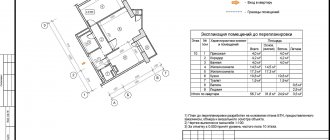What is a cadastral plan of a land plot?
A cadastral plan of a territory is an official land registration document that regulates the main property positions of the landowner, defining its total area, its inherent configuration and boundaries in relation to other areas located in the massif.
This is a map of the area, compiled using the latest topographic technologies, which allows you to establish the boundaries of the territory with a minimum error (5-10 cm).
It is compiled not only in relation to the memory. Other real estate objects, including structures and buildings, are also subject to topographic registration. These are directly connected to the land and are not taken into account separately from the site in the plan. That is, in this case, a contextual unity of land and capital buildings - inventory units - is formed.
Subsequently, land plots are transferred from the plan, for which a land survey is drawn up. They already include capital buildings in a text document, in the form of an extract.
And for capital buildings, technical plans are formed based on information copied from the cadastral plan.
The cadastral plan, therefore, can be considered a basic document, an information source for cadastral and inventory registration of real estate. Instructions for obtaining it are described in detail here.
What does a cadastral plan of a land plot look like:
Example No. 1
Example No. 2
Example No. 3
Using the cadastral plan, you can find out the cadastral number. Read more information on this topic in other materials:
- What does the cadastral number look like?
- What is the difference between the old KN and the new one?
- How to obtain this document?
If you don’t know your number and don’t have a plan, then you can find out at:
- cadastral number of an apartment, house and building, land plot;
- cadastral value of the property;
- other information.
Making changes to the cadastral plan
If significant changes have been made to the site or premises: a house has been built, an old building has been demolished, or several rooms have been combined into one. To make changes, you need to submit an application in person or through the MFC to the Rosreestr branch in your region. It is necessary to have a package of documents, which includes:
- cadastral passport of the object in which changes are needed;
- passport of a citizen of the Russian Federation who is the owner of the object;
- ownership documents or notarized power of attorney;
- an application for making the necessary changes indicating their list.
The cadastral plan, necessary for any official transactions with real estate, is a mandatory document and an important part of the general cadastral passport of the property. The document itself, as well as changes made to it, are drawn up after an application to the local representative office of Rosreestr. The cadastral plan is used for all types of real estate transactions, including collateral for mortgage lending.
Types of cadastral plans
Since the cadastral land plan performs many functions, dividing into more specific sources of topographic information, it is usually classified by type:
- The land survey plan is the legal and practical element of the “land survey” package. It is compiled in relation to land, establishing the parameters of boundaries with neighbors, fixing the turning points of the boundaries of the land plot, its configuration, area and location in the array. Consists of a topographical and text document.
- Technical plan of a house (floor plan) - a plan of a finished capital structure recognized as residential. Contains information about the number of floors, indicating the location of each room on the floor. Mandatory - with determination of the area of each room, as well as the total area of the house. This takes into account common areas and technical premises.
- A technical construction plan is drawn up for non-residential and industrial buildings. These include hangars, warehouses and the like. This type of document establishes the general parameters of each accounting unit in general, without splitting the structure of the structure into parts, as, for example, in a residential building.
- The technical plan of the rooms takes into account the individual elements in the building intended for the residence of citizens. It is built on a floor-by-floor basis.
- The technical plan for unfinished construction allows for formation at any stage of the construction of a capital structure. Changes in accordance with the amount of work performed. It loses its relevance at the moment the house or building is put into operation.
Each type of document is of equal importance for cadastral or inventory registration.
Regulatory requirements for preparing a boundary plan
The structure of the boundary plan allows you to accurately establish the key quantitative characteristics of the land plot. According to current legislation, the work is performed by a cadastral engineer with a valid certificate. Requirements for the structure, content and execution of the document are defined by the following regulations:
- Federal Law of July 13, 2015 No. 218-FZ;
- Federal Law of July 24, 2007 No. 221-FZ;
- Order of the Ministry of Economic Development of Russia dated December 8, 2015 No. 921.
The general requirements for the structure of the boundary plan are enshrined in Article 22 of Federal Law No. 218. The document must include text and graphic parts, and is produced in written (at the customer’s request) and electronic forms (priority format). The basis for preparing the document is an extract from the Unified State Register or a cadastral plan of the territory. During the work, the cadastral engineer collects and enters information into the boundary plan:
- Information about the property being created, which is the basis for cadastral registration.
- Data on the autonomous parts of the site, each of which is registered with the cadastral authorities.
- New information on the characteristics of land ownership obtained during cadastral work.
According to legal requirements, any cadastral work on a site necessarily ends with the signing of an act of coordination of boundaries with the owners of adjacent landholdings. The act of approval is an important component of the boundary plan; in the event of land disputes, it serves as an argument for the court.
Regulatory requirements for sections and points of the boundary plan are determined by Order of the Ministry of Economy and Development No. 921. Some sections are mandatory, others vary depending on the type of cadastral work. Mandatory points of the boundary plan include:
- general information about the work performed by the cadastral engineer;
- initial data;
- data on calculations and measurements performed;
- object location diagram;
- drawing of the land plot.
Additional sections specified in Order No. 921:
- information about the land plots being formed (one or more independent units are separated from the entire object);
- data on changed land plots (by agreement between the owners, the size of shares in the land changes);
- information about the specified land plots;
- information on ensuring access to newly created or changed plots;
- data on parts of the site;
- conclusion of a cadastral engineer (to justify the location of the specified boundaries, the engineer refers to specific objects of artificial origin that fix the boundaries on the ground - building walls, concrete fencing);
- act of approving the boundaries of a land plot.
More detailed information about the requirements for the structure and content of the boundary plan can be found in the specified regulatory documents or clarified in consultation with a cadastral engineer.
Why do you need a cadastral plan of a land plot?
Based on the cadastral plan of Russia, registration registration actions are carried out, real estate objects are registered with the state real estate cadastre (GKN). Only after registration, real estate acquires legal capacity and is allowed to participate in property transactions and other civil legal actions.
Land surveying is required to determine the boundaries of the site . On its basis, turning points of the boundaries are established, which makes it possible to draw precise lines of delimitation of the memory and determine the configuration of each of them. On its basis, disputes are resolved and rules for the use of plots between neighbors are regulated.
Technical plans for objects are necessary for registering them . Without their proper registration, apartments and houses are not allowed to be alienated, and also cannot act as a subject of collateral value for credit institutions.
Cadastral passports for real estate objects are issued only on the basis of the specified documentation. Valuation and inventory activities are also carried out, authorized by the municipality, with the transfer of information to the tax office.
The differences between a cadastral plan and a passport can be found in our other article.
Useful video from Architect Vitaly Zlobin:
Features for forest area
According to the current legislation of the Russian Federation, the cadastral registration of forest lands can only be carried out if they are used for recreational activities .
For the uninitiated, this is an activity related to wellness procedures, such as:
- Sanatorium rest;
- Tourism;
- Sports fishing, etc.
Drawing up a cadastral plan directly in this case will not differ much from the actions described above, since legally forest lands are equated to land.
You just need to indicate in the appropriate section the desired category of land use, such as forest lands.
How to read it?
Reading the document is made easier by the fact that it is compiled on several forms, from which you can quickly select the required information. Their designation according to functionality is recorded in the top line of the form.
- The first form indicates the essential cadastral and technical characteristics of the object. Information about the project executor and details of the legal entity are also provided here.
- The following form contains the general configuration of the site indicating the coordinates of the turning points of the memory. It is included in the general array, but separated from it by a special line. Here is information about how boundaries should be positioned, not taking into account the possibility of self-capture, overlapping boundaries and other nuances that require correction.
- In the third section, the previously indicated topographical information is given in text form, in the form of a description of the memory.
- The last two sections are used as necessary if the site has special parts allocated during design or when it is encumbered with an easement.
Each form corresponds to a specific section in which the listed information is classified.
What parts does it consist of?
The contents of the cadastral document are established and executed in accordance with Order of the Ministry of Economy No. 378.
In particular, this order establishes twelve sections that represent acceptable official forms for filling out cadastral documentation. Each section is intended to describe certain technical characteristics of a real estate object.
Sections are organized for convenience into 5 main parts:
- General information.
- Territory plan.
- Text information.
- Description.
- Object diagram.
General information about the memory
The first part of the document is text information. Here a description of the land plot is indicated, indicating information about its location and technical characteristics of the immovable object. The section contains the following information:
- individual land plot number;
- cadastral document number;
- boundaries, area, dimensions;
- owner;
- registration data.
In the Cadastral Chamber, after registration, a plot of land is assigned an individual unique number, which allows individuals and legal entities to subsequently register ownership of a real estate property (how such a cadastral number is obtained and why it is needed, we tell you in more detail here, and from this article you find out where and how you can check its availability).
Drawing
The second part presents a graphic image of the allotment or its drawing in landscape format. It is drawn up by a cadastral engineer after visiting for survey work. The drawing provides information:
- allotment form;
- boundaries;
- engineering facilities or communications located on the ground, their characteristics are also briefly described;
- location of objects inside the allotment;
- outlines of buildings.
Text information about the features of the location of the object
This part provides a text description of the features of the location of the land territory.
To do this, a justification is given for drawing boundaries, their dependence on the terrain, the proximity of neighboring plots and other objects, as well as what factors influenced the execution of the drawing. If there are adjacent territories and neighboring plots, the description indicates this information in the form of distance segments between them, especially if there are common boundaries. This is very important information, since when receiving a cadastral plan, the boundaries may be disputed by the owners.
Description of memory division
The following form shows the zonal division of the site after cadastral work. The allotment is divided into shares that have:
- individual name;
- own purpose;
- objects located on the lobes are indicated.
As a standard, zones that are divided functionally are indicated:
- residential buildings;
- vegetable garden, garden part, immovable greenhouses;
- rest zone;
- bodies of water;
- economic part.
In addition to this information, rental parts and sectors are indicated without limitation, but belonging to the described site (for example, gardens, parking lots).
Layout diagram
This is another graphic plan. This diagram is worked out on a small scale in order to display the location of the land plot in relation to neighboring territories.
Based on this drawing, conclusions are drawn about the location of access roads to the site, location on the landscape and relationship with surrounding areas.
Knowing the cadastral number of the plot, you can access various data about the land plot. In our separate publications you will read how, with such information, you can find out the owner, address and cadastral value of the plot.
Extract
The designated plan, which is stored in the State Property Committee, can be obtained for use in the form of an extract from the cadastral plan of the land plot. This is an official document that gives a basic idea of the memory, which can be provided at the request of certain authorities.
The extract contains mandatory information:
- Basic information about the memory.
- Drawing of the memory, indicating the scale of execution.
- Drawing and text description of capital and other buildings located on the territory of the land plot.
- Highlighting the boundaries of the designated area with a red line. Description of turning points indicating their coordinates.
- Identification of the internal boundaries of parts of the site that are burdened with easements or have other nuances of use. If there are no encumbrances, this fact is indicated.
This document is executed exclusively by a qualified specialist - a cadastral engineer who has a license for the designated type of activity.
Read even more useful information on the topic in the Cadastral number section.
Who needs a boundary plan?
The help of a qualified specialist in conducting land surveying and drawing up this plan may be useful if you plan to carry out the following operations with the land:
- Divide or combine;
- Correct identified cadastral errors;
- Select shares;
- Redistribute;
- Give, buy or sell;
- Specify the location;
- Form a new land tenure from state or municipally owned lands;
- Form a new plot by merging several adjacent properties.
The boundary plan is prepared on the basis of data available in Rosreestr - in the cadastral extract or cadastral plan of the territory. In some cases, for high-quality document preparation, a specialist may need up-to-date cartographic materials and land survey papers.
How to read?
Reading the cadastral plan begins with the first part of the document and is studied sequentially.
The content uses three-digit numbers on the pages, which are the numbers of points, boundaries, drawing pictograms, which are deciphered on each diagram. The upper parts of the plan or image are explained as the northern direction of the site, and the lower parts - the southern direction. To calculate the distance and size of the plot, use the indicated scale on the page.
What do the red lines mean?
A feature of the graphic image in the cadastral document is the red lines. On the diagram and drawings they are drawn to indicate the boundaries that separate territorial plots from neighboring areas. At the request of the owner or drafter of the document, red lines can indicate the division of the territory into several shares.
As a rule, this designation technique is used when there is a need for symbols to carry out a number of actions (for example, indicating corners, dividing the territory into sections).
The cadastral plan of a land plot is a graphic and text document that contains a variety of information about a real estate property. The plan consists of five consecutive sections that serve as a supplement or explanation of the previous one. To read the plan, you need to study the textual information, compare the scale of drawing lines, and look at the surveyor’s explanations.






